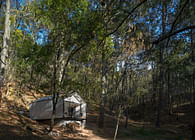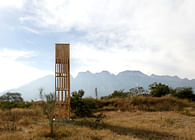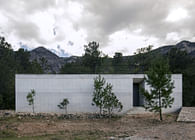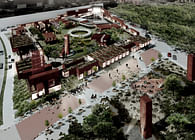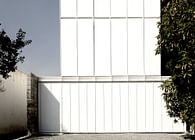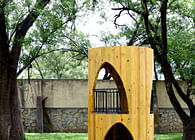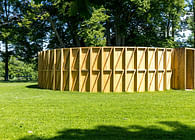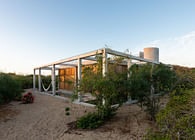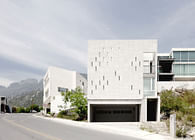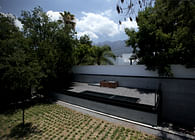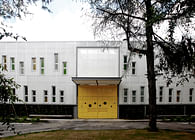
La Villa de Santiago is a colonial town located 37 kilometers from the city of Monterrey. Every week a large number of visitors come to enjoy the different natural scenarios held in this part of the Sierra Madre Oriental. Rivers, waterfalls and forests are a perfect place to practice canyoning, climbing and trekking. Traditionally many weekend residences and cottages are located here. That is the case of this construction, placed in a terrain with view to the nearby mountains on the outskirts of the town.
The pavilion is placed in one of the ends of a spacious garden. It is formed by 2 main pieces: one platform made of red brick that includes a space for an enigmatic black pool, and a structure of metallic elements forming a roof with a dried reed straw skin on the inside and a glass surface on the exterior, providing both shade and protection. Three volumes or boxes organize the space, each with a different material: a volume made of concrete for the bar and grill, a metallic one for the extraction hood and chimney and the last one made of concrete block holding the storage and bathroom.
The pavilion is placed in front of a stairway of railroad ties that retain the different levels of the garden area, making the most of this condition generating more sitting area for the gathering.
In spite of its simple geometry, the elements forming this space bring a great optic and haptic richness through its textures, modulation and its contrasting yet complementing colors. The remembrance of the elemental materiality of each piece and its own unit form a whole.
In the same way, the pavilion holds a strong dialog with the surrounding elements: mountains, garden, wind and light.
Status: Built
Location: Monterrey, MX
Firm Role: Architects
Additional Credits: Project: Miraloma Pavilion
Architecture: S-AR
Website: www.s-ar.mx
Location: Santiago, Nuevo Leon, Mexico.
Architects in charge: Cesar Guerrero, Ana Cecilia Garza.
Collaborators: Carlos Morales
Programme: Outdoors Pavilion
Client: Private
Construction area: 63.5 sqm.
Project year: 2017
Construction year: 2020
Photography: Ana Cecilia Garza Villarreal

